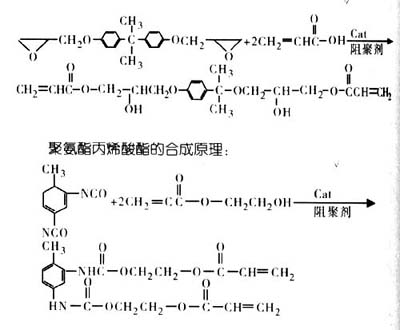Abstract : Epoxy acrylate and urethane acryl are synthesized as UV curable inks with prepolymers. The concept of wavelength matching initiators and pigments is proposed. The optimization of the four main color ink formulations is completed. Foreign general-purpose performance standards.
Keywords: epoxy acrylate polyurethane acrylic UV curable ink
Uv curing technology has its own characteristics and advantages, and it has developed rapidly in the field of fine chemicals. Because of the solvent-free volatilization of uV curing technology, it protects the environment, saves resources, and has enormous economic and social benefits. For the printing industry, Uv curing inks can be cured at room temperature or at lower temperatures to save energy, cure quickly, and do not require additional drying equipment. In the printing project, the quality of the printed sheets can be avoided by blocking or overlapping between the front and back sheets, which is suitable for continuous production. The productivity can be greatly improved, the storage space can be reduced, the performance of the uV curing ink is excellent, and the quality of the printed materials printed by the UV-curable ink is high "1-4".
uV curing inks have long been studied abroad. In recent years, many products have been introduced to the market "5." In the domestic introduction of UV-curing printing equipment, it also imports Uv curing inks. Taking into account the large number of middle- and low-grade prints, this study analyzed the performance of UV-free radical-curable inks for structural formulation and development.
UV curing ink consists of three parts: binder, pigment and related auxiliary agent. UV radical curing ink under ultraviolet light, the initiator initiates the free radical polymerization of the unsaturated bond in the connecting material, and the ink is cured to form a film. There are many oligomers that can be used as curing agents for uV radical curing agents. Considering the curing speed, adhesion after curing, toughness and gloss, the bisphenol A type is selected based on the price, source comparison, and requirements for middle- and low-grade prints. Epoxy acrylate and urethane acrylate are used as prepolymer "6-7".
The epoxy acrylate synthesis principle is as follows:

1 Experimental section
1.1 Raw materials
Bisphenol A Epoxy Resin, Industrial Products; Acrylic Acid, Chemically Pure; Toluene Diisocyanurate (TDl), Chemically Pure; Hydroxyethyl Acrylate (HEA), Chemically Pure; Pigments, Catalysts, Polymerization Inhibitors, etc. Industrial grade.
1.2 Synthesis of Epoxy Acrylates
Batch polymerization method was used. Add a certain amount of epoxy resin to the 3-necked flask, add a small amount of polymerization inhibitor and catalyst, stir well, and slowly add the acrylic equivalent weight equivalent to the epoxy resin with a constant pressure funnel and add dropwise at a certain temperature. After completion, the reaction was stopped until the acid value was less than 2-5 mg (KOH/g). The reaction was cooled and the material was cooled, namely epoxy acrylate. The acid value was measured using a KOH-ethanol solution titration. The size of the acid value reflects the degree of acrylic acid conversion.
Synthesis of 1,3 urethane acrylate
Batch bulk polymerization was used. In a flask equipped with a stirrer and a thermometer, a certain amount of toluene diisocyanate (TDl) was added, and then a certain amount of catalyst DBT and a certain amount of polymerization inhibitor were added. After stirring, hydroxyl acrylate was added dropwise with a constant pressure dropping funnel. The amount of ester (HEA) is matched to the amount of TDI. At 60-80 ° C to the end of the reaction, the free isocyanate content in the reaction is less than o. 5% is the end of the reaction. The content of isocyanate is determined by the di-n-butylamine method, which is a data indicator for controlling the isocyanate conversion in the reaction.
2 Results and Discussion
2,1 Synthesis of Prepolymers
The synthesis of epoxy acrylate is tested by single factor test and comprehensive repeated test. The preferred reaction conditions are: the epoxy molar amount of epoxy resin and the molar amount of acrylic acid are 1:1, otherwise the acid value is not too large and there is surplus. Epoxy value, making the product unstable; Acrylic acid dropping temperature does not exceed 85 °C; After the completion of dropping, Insulation 110-120 °C, 4h reaction can reach the end; Catalyst dosage 0.2%; Polymerization inhibitor Add about 0.06%.
The synthesis of urethane acrylate was tested by conditions, and the better reaction conditions were as follows: DBT was used as the catalyst, 0.1% was more preferred; the amount of polymerization inhibitor was 50010-6; r(TDl): r(HEA)= 1:2; HEA dropping, 60-65°C, reaction 3-4h.
(to be continued)
NINGBO HOZ TRADING CO.,LTD , https://www.hoz-kitchenware.com